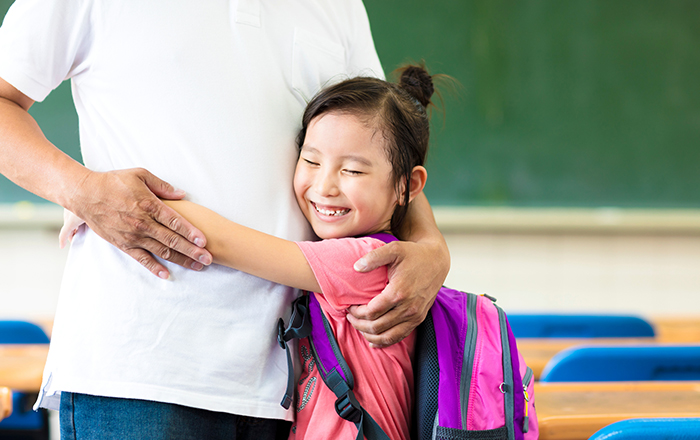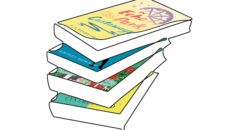Raising adoption awareness at school helps create the open, accepting environment that lets our children flourish. Here, AF gives you the words to say, books to read, and projects to suggest to your child’s teacher.
Write a letter to your child’s teacher.
By briefly explaining your family’s background and providing her with language to use when talking about adoption in the classroom, you make it clear that you:
- believe that families are created through love, not genetics;
- believe that adoption is something to be celebrated, not hidden;
- are available as a resource in the classroom.
Read an adoption storybook to the class during story time.
An engaging tale is a great way to introduce a new topic to younger kids. Use a book to begin an adoption presentation, or simply offer to read to the class during regular story hour. AF readers’ favorites include:
- All About Adoption, by Marc Nemiroff (Magination Press; ages 4-8). This introductory book explains adoption and explores different feelings children may experience as they grow.
- How I Was Adopted, by Joanna Cole (Harper Trophy; ages 4-8). This well-known children’s book is notable within adoption literature for beginning with and explaining birth.
- A Mother for Choco, by Keiko Kasza (Putnam Juvenile; ages 3-6). A little bird searches for a mother and is welcomed into Mrs. Bear’s home. This sweet story is very reassuring for young kids.
- Tell Me Again About the Night I Was Born, by Jamie Lee Curtis (HarperTrophy; ages 4-10). This now-classic tale is less didactic than most adoption books. The storyline is sure to capture all kids’ interest.
To keep adoption stories on the radar year-round, donate a set of books to your child’s classroom.
Give an adoption presentation in first or second grade.
This is a wonderful way to educate your child’s peers, and teachers are usually enthusiastic. Explain adoption in a general way, rather than tell your child’s particular story. Using dolls or other props will help non-adopted kids relate.
Here’s a simple, parent-tested presentation to use as a model:
- Bring in one of your child’s dolls or stuffed animals. Tell everyone her name — Sandy, for example — and let each student hold her.
- Ask the kids to help complete two lists on the blackboard: “What babies need” (bottles, food, clothes, hugs, and so on) and “What parents do” (feed, clothe, change, hug and kiss, and so on). If the kids don’t say “bring babies into the world,” add it to the parents’ list.
- Tell them that Sandy’s birth parents brought her into the world, but that they realized they could not do all the other things parents do.
- Tell them that Sandy’s forever parents wanted to do all those things for her, even though they didn’t bring her into this world.
- Finish by explaining that Sandy has two sets of real parents — her real birth parents and her real forever family — and that she needs both to be who she is.
- Don’t forget food! End your classroom presentation with a snack.
Educate other parents.
The parents of your child’s classmates may wonder how to talk to their children about adoption. Give them a hand by sending “Helping Classmates Understand Adoption” home with the students in your child’s class.
AF’s handout provides conversation guidelines and sample Q & As — and sends the message that adoption is a wonderful and normal way to build a family.
Suggest a community service project around National Adoption Day, which falls on the Saturday before Thanksgiving.
This day celebrates the adoptions of children in foster care around the U.S. Your child’s class might accept donations of food and clothing for foster families, make cards thanking foster parents for the important work they do, or donate and wrap holiday gifts for local foster kids. Visit nationaladoptionday.org for more ideas.
Parental involvement is often the key to a successful school year.
Let the teacher know that you’re an ally. Schedule a one-on-one meeting early in the school year to introduce yourself and your family. This will give you a chance to:
- Let her know how to handle adoption-related topics that may come up in the classroom. For example, if you are in an open adoption, let her know that your child may mention her birth family.
- If you are a single parent, give examples of how you’d like her to handle the “missing daddy” question, (e.g. “Tommy’s family doesn’t have a daddy. His family has a mommy, a brother, and a sister”).
- Ask if she’s planning assignments that require baby photos or information (the family tree, an autobiographical timeline, “star of the week”) and present alternatives.
- Offer to give a classroom presentation, talk to other teachers, or simply be on call for questions that arise. If a teacher hasn’t had much experience with the topic before, such an offer will be reassuring — and will help her understand that adoption is not unmentionable.
Introduce the topic of racial differences in people around the world.
Many children, especially those who live in relatively homogenous parts of the country, benefit from learning how children around the world look, what they wear, and how they live. These books are good places to start:
- We’re Different, We’re the Same, by Bobbi Kates (Random House; ages 3-8). Familiar Sesame Street characters introduce young readers to people of different ethnicities.
- Children Just Like Me, by Anabel Kindersley (Dorling Kindersley; ages 8-12). This photo-filled book is an engaging look at children around the world.
- If the World Were a Village, by David Smith (Kids Can Press; ages 8-12). This beautifully illustrated book reduces the world’s population of 6.2 billion people to 100, making it easier for kids to grasp the prevalence of different ethnicities, religions, languages, and so on.
Help teachers rethink sticky assignments.
Projects designed to explore a child’s past can be difficult for our kids. Encourage your child’s teacher to present several options to the entire class, not just to your child. Here are ideas for more inclusive projects:
- Family Tree: Students can draw themselves on the trunk of a tree and someone whom they love on each branch, regardless of biological or adoptive relationships. Or they can place names of adoptive family members in the branches of a tree and birth family members in its roots. Using a house metaphor in lieu of a tree allows flexibility to incorporate all members of a child’s family.
- Timeline: Instead of starting with their birthdates, children can cite memorable events from each calendar year they’ve been alive; older students can create a timeline that includes a national or world event from each year they have been alive.
- Star of the Week: Request that students bring in photographs of themselves from a year or two ago, rather than baby photos.
Arm your child with answers to questions she may be asked in class or on the playground.
Your child may want to give different answers, depending on her mood. Here are a few options you can propose:
Q: “Where do you come from?”
A: “What do you mean? Are you asking where I was born or where I live?” or “New York.”
Q: “Is that your real mother?”
A: “Yes. She dropped me off at school today,” or “Do you mean my birth mother? I don’t live with my birth mother.”
Q: “Why didn’t your real mother want you?”
A: “Are you asking why I was placed for adoption?” or “My birth mother couldn’t take care of me, but she made sure I was adopted by my parents,” or “That’s private.”
Q: “Why don’t you speak Chinese?”
A: “I am American like you, so I speak English.”
Celebrate your child’s adoption day at school.
Just as children often celebrate birthdays at school, adoptive families may plan classroom festivities to honor their children’s adoption days.
We can visit our child’s classroom to read a book — like We Adopted You, Benjamin Koo, by Linda Walvoord Girard (Albert Whitman & Co.; ages 4-8), or Happy Adoption Day, by John McCutcheon (Little, Brown; ages 2-6) — and cap off the occasion with treats.
If you adopted an older child, ask him if he’d like to celebrate his finalization or naturalization with his classmates.
Place adoption in the broader context of nontraditional families.
Ask the teacher or curriculum director to plan a unit on nontraditional families, including single-parent, step-, gay/lesbian, grandparent-headed, and adoptive. Here are some books and videos that send an inclusive message:
- Families Are Different, by Nina Pellegrini (Scholastic; ages 4-8). When an adoptee worries that she doesn’t look like her family, her mom helps her understand that all families are different.
- The Family Book, by Todd Parr (Little, Brown; ages 3-6). This cheery, colorful book sends the message that diversity is a natural part of life. The book is perfect for preschoolers.
- All Families Are Different, by Sol Gordon (Prometheus Books; ages 4-8). Written from a child’s point of view, this book suggests sample responses kids can use. For example, “If other kids tease you because your family is ‘different,’ just say, ‘Yeah, they are! All families are different.’”
- That’s a Family, by GroundSpark (formerly Women’s Educational Media; ages 8-12). This 30-minute documentary film introduces viewers to real families in all different shapes and sizes. Teachers can use the Discussion and Teaching Guide to plan related lessons.
Teach the teachers.
Write to the school principal or Parent-Teacher Association to suggest a professional training session about adoption and alternative families for the school’s faculty. Look for a nearby organization that offers programs like the ones run by The Center for Adoption Support and Education, in Silver Spring, Maryland, that can address children’s understanding of adoption at different ages, adjusting assignments for family diversity, and talking about differences.
Here are five vital points for education professionals to understand:
- Adoption is an open and natural topic in your family. Teachers should not be afraid to discuss it or to answer students’ questions.
- Children born in a different country are not experts on the language or culture of that country.
- There are neither real families nor fake families. Adoptive parents are parents like any others.
- Genetics and immigration can be taught without requiring students to trace their nuclear family’s roots.
- Parents of all types will appreciate more inclusive versions of “star of the week,” as well as autobiographical timeline and family tree projects.
When presenting adoption to 10-year-olds, the teacher’s cooperation and your child’s involvement are key.
Read an account of one parent’s adoption presentation: Adoption 101 in Room 26.
Help the teacher blend adoption into the curriculum.
Mentioning adoption from time to time in a matter-of-fact way helps kids see that adoption is a normal life experience for many families.
For example, when studying biology and genetics in science class, adoption can be discussed in the context of nature vs. nurture. In a unit on immigration, the teacher can tell students that more than 20,000 young children become U.S. citizens each year via international adoption.
Give the teacher ready-made answers for common classroom adoption questions:
Q: “Where are Ben’s real parents?”
A: “Ben’s real parents are the parents who are raising him, John and Kathy, who pick him up from school each day. He also has birth parents who gave birth to him.”
Q: “Why didn’t Ben’s first family want him?”
A: “They probably wanted him very much but couldn’t take care of any baby at that time. They wanted him to have a family to love him and take care of him forever.”
Q: “Where is Ben from?”
A: “He’s from Ohio. He was born in Russia, but now he’s a U.S. citizen, like you.”
Q: “Does he speak Russian?”
A: “No. Ben came to the U.S. when he was a baby. He was not speaking any language at the time! Children speak the language of the country they are raised in, just as you speak English and not the language your grandparents spoke before they immigrated to the U.S.”
Donate a packet of educator materials to the school.
For even more talking guidelines, alternatives to sticky assignments, and strategies for generally making the classroom a supportive, welcoming environment for all children, provide your child’s teacher or school with copies of:
- Adoption and the Schools — Adoption organization Families Adopting in Response put together this 250-page resource for parents and teachers.
- An Educator’s Guide to Adoption — A reference booklet about creating a parent-teacher partnership, published by the Institute for Adoption Information.
- S.A.F.E. at School — Strategies from the Center for Adoption Support and Education for ensuring an adoption-friendly school environment.
Celebrate the many cultures of the world.
Many school curricula include international culture fairs or country reports. Volunteer to make dishes from all cultures of origin in your family, or to read a traditional folktale, play music, or bring in clothing or artifacts.
Encourage the school to observe diverse holidays, such as Cinco de Mayo, Kwanzaa, Chinese New Year, and Diwali. Holiday activities are naturally engaging ways to introduce kids to other cultures. In December, for example, kids will get a kick out of seeing how people around the world celebrate Christmas.
Children Just Like Me: Celebrations, by Anabel Kindersley (Dorling Kindersley) is a fascinating look at holidays around the globe. Or, your child’s classmates will enjoy hearing the Cinderella tale as it’s told in his birth culture. From Baba Yaga & Vasilissa (Russian) to Cendrillon (French Creole), storybook retellings from around the world can be lots of fun for kids of all ages.



